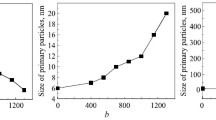The low-temperature phase stability of 97 mol.% ZrO2–3 mol.% Y2O3, 95 mol.% ZrO2–3 mol.% Y2O3–2 mol.% CeO2, 92.5 mol.% ZrO2–2.5 mol.% Y2O3–5 mol.% CeO2, 90 mol.% ZrO2–2 mol.% Y2O3–8 mol.% CeO2, and 88 mol.% ZrO2–12 mol.% CeO2 materials in the ZrO2–Y2O3–CeO2 system was studied. The phase stability was determined through accelerated aging in hydrothermal conditions for 7 h and 14 h. The evaluation criterion was the amount of the M-ZrO2 phase that formed in the samples when aged in hydrothermal conditions. The properties of the materials were analyzed by X-ray diffraction and electron microscopy. The T-ZrO2 → M-ZrO2 phase transformation occurred to varying degrees in all samples except for the 88 mol.% ZrO2–12 mol.% CeO2 sample after the first and second aging cycles. The smallest amount of M-ZrO2 formed in the 90 mol.% ZrO2–2 mol.% Y2O3–8 mol.% CeO2 sample. After both aging cycles, the fracture patterns for the 90 mol.% ZrO2–2 mol.% Y2O3–8 mol.% CeO2 and 88 mol.% ZrO2–12 mol.% CeO2 samples did not change significantly. With the complex stabilization of zirconia by yttria and ceria, the T-ZrO2 → M-ZrO2 phase transformation was controlled in the aging process by the number of oxygen vacancies resulting from the presence of yttria and by the stresses induced by the presence of ceria in the solid solutions. The number of oxygen vacancies decreased as ceria content in the ZrO2-based solid solutions increased, slowing down the rate of water diffusion and enhancing the low-temperature phase stability in the ZrO2–Y2O3–CeO2 materials. The effectiveness of using the 90 mol.% ZrO2–2 mol.% Y2O3–8 mol.% CeO2 and 88 mol.% ZrO2–12 mol.% CeO2 composites for the microstructural design of medical materials with increased resistance to low-temperature degradation in humid environments was shown.




Similar content being viewed by others
References
J. Chevalier and L. Gremillard, “Ceramics for medical applications: A picture for the next 20 years,” J. Eur. Ceram. Soc., 29, No. 7, 1245−1255 (2009), doi:https://doi.org/10.1016/j.jeurceramsoc.2008.08.025.
S. Ramesh, K.Y. Sara Lee, and C.Y. Tan, “A review on the hydrothermal aging behavior of Y-TZP ceramics,” Ceram. Int., 44, Issue 17, 20620−20634 (2018), doi:https://doi.org/10.4047/jap.2020.12.5.265.
J.E.V. Amarante, M.V.S. Pereira, G.M.D. Souza, M.F.R. Pais-Alves, B.G. Simba, and C.D. Santos, “Effect of hydrothermal aging on the properties of zirconia with different levels of translucency,” J. Mech. Behav. Biomed. Mater., 109, 103847 (2020), doi.org/https://doi.org/10.1016/j.jmbbm.2020.103847.
J. Chevalier, L. Gremillard, and S. Deville, “Low-temperature degradation of zirconia and implications for biomedical implants,” Ann. Rev. Mater. Res., 37, 1−32 (2007), DOI:https://doi.org/10.1146/annurev.matsci.37.052506.084250.
H. Schubert and F. Frey, “Stability of Y-TZP during hydrothermal treatment. Neutron experiments and stability considerations,” J. Eur. Ceram. Soc., 25, 1597−1602 (2005), https://doi.org/10.1016/j.jeurceramsoc.2004.03.025.
J. Chevalier, Al. Liens, H. Reveron, F. Zhang, P. Reynaud, Th. Douillard, L. Preiss, V. Sergo, V. Lughi, M. Swain, and N. Courtois, “Forty years after the promise of “ceramic steel”: zirconia-based composites with a metal-like mechanical behavior,” J. Am. Ceram. Soc., 103, 1482–1513 (2020), https://doi.org/10.1111/jace.16903.
C. Santos, I.F. Coutinho, J.E.V. Amarante, M.F.R. Pais Alves, M.M. Coutinho, and C.R.M. Silva, “Mechanical properties of ceramic composites based on ZrO2 co-stabilized by Y2O3–CeO2 reinforced with Al2O3 platelets for dental implants,” J. Mech. Behav. Biomed. Mater., 116, 104372 (2021), doi.org/https://doi.org/10.1016/j.jmbbm.2021.104372.
E.V. Dudnik, S.N. Lakiza, Ya.S. Tishchenko, A.K. Ruban, V.P. Redko, A.V. Shevchenko, and L.M. Lopato, “Phase diagrams of refractory oxide systems and microstructural design of materials,” Powder Metall. Met. Ceram., 53, No. 5–6, 303–311 (2014).
I.O. Marek, O.K. Ruban, V.P. Redko, M.I. Danilenko, S.A. Korniy, and O.V. Dudnik, “Physicochemical properties of hydrothermal nanocrystalline ZrO2–Y2O3–CeO2 powders,” Powder Metall. Met. Ceram., 58, No. 3–4, 125–132 (2019).
I.O. Marek, O.V. Dudnik, S.A. Korniy, V.P. Redko, M.I. Danilenko, and O.K. Ruban, “Effect of heat treatment in the temperature range 400–1300°C on the properties of nanocrystalline ZrO2–Y2O3–CeO2 powders,” Powder Metall. Met. Ceram., 60, No. 7–8, 385–395 (2021).
V.G. Zavodinskii, “Studying the mechanism of phase stability of zirconium dioxide doped with magnesium and calcium,” Perspekt. Mater., No. 2, 5−9 (2005).
L. Ping, Ch. I-Wei, and P.-H.E. James, “Effect of dopants on zirconia stabilization—an X-ray absorption study: I. Trivalent dopants,” J. Am. Ceram. Soc., 77, No. 1, 118–128 (1994).
L. Ping, Ch. I-Wei, and P.-H.E. James, “Effect of dopants on zirconia stabilization—an X-ray absorption study: II. Tetravalent dopants,” J. Am. Ceram. Soc., 77, No. 5, 1281–1288 (1994).
Sh. Jiang, X. Huang, Zh. He, and A. Buyers, “Phase transformation and lattice parameter changes of non-trivalent rare earth-doped YSZ as a function of temperature,” JMEPEG, 27, 2263–2270 (2018), DOI: https://doi.org/10.1007/s11665-018-3159-3.
R.D. Shannon, “Revised effective ionic-radii and systematic studies of interatomic distances in halides and chalcogenides,” Acta Crystallogr., A32, 751–767 (1976), https://doi.org/10.1107/S0567739476001551.
P.F. Manicone, P.R. Lommetti, and L. Raffaelli, “An overview of zirconia ceramics: Basic properties and clinical applications,” J. Dent., 35, 819−826 (2007), DOI: https://doi.org/10.1016/j.jdent.2007.07.008.
R.H.J. Hannink, P.M. Kelly, and B.C. Muddle, “Transformation toughening in zirconia-containing ceramics,” J. Am. Ceram. Soc., 83, No. 3, 461–487 (2000), https://doi.org/10.1111/j.1151-2916.2000.tb01221.x.
S. Deville, J. Chevalier, and H. El Attaoui, “Atomic force microscopy study and qualitative analysis of martensite relief in zirconia,” J. Am. Ceram. Soc., 88, No. 5, 1261–1267 (2005), https://doi.org/10.1111/j.1551-2916.2005.00174.x.
M.W. Pitcher, S.V. Ushakov, A. Navrotsky, B.F. Woodfield, G. Li, J. Boerio-Goates, and B.M. Tissue, “Energy crossovers in nanocrystalline zirconia,” J. Am. Ceram. Soc., 88, No. 1, 160–167 (2005), https://doi.org/10.1111/j.1551-2916.2004.00031.x.
Author information
Authors and Affiliations
Corresponding author
Additional information
Translated from Poroshkova Metallurgiya, Vol. 61, Nos. 11–12 (548), pp. 116–126, 2022.
Rights and permissions
Springer Nature or its licensor (e.g. a society or other partner) holds exclusive rights to this article under a publishing agreement with the author(s) or other rightsholder(s); author self-archiving of the accepted manuscript version of this article is solely governed by the terms of such publishing agreement and applicable law.
About this article
Cite this article
Marek, I.O., Dudnik, O.V., Korniy, S.A. et al. Effect of the ZrO2-Based Solid Solution on the Low-Temperature Phase Stability of ZrO2−Y2O3−CeO2 Materials. Powder Metall Met Ceram 61, 727–735 (2023). https://doi.org/10.1007/s11106-023-00359-4
Received:
Published:
Issue Date:
DOI: https://doi.org/10.1007/s11106-023-00359-4




